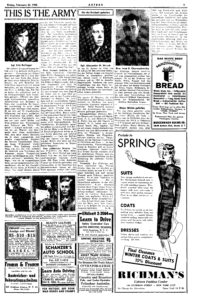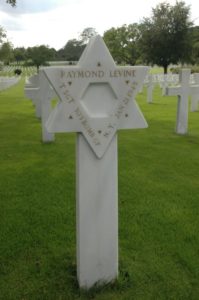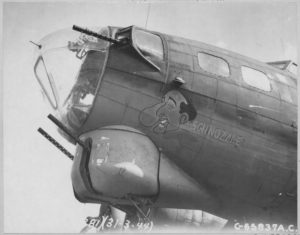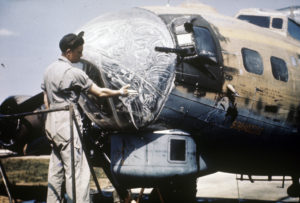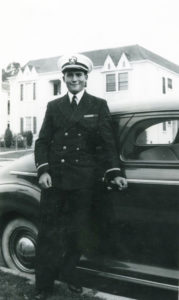Oftimes in our world, a “story” – ostensibly minor and of little immediate notice – is embedded within a larger tale, and will only become revealed; it not apparent; if not finally noticed, with the passage of time:
Think of a Russian Matryoshka doll, manifest in words and memories…
One such story – in reality, a multiplicity of stories, part of the larger historical episode of the participation of Jewish soldiers in the Second World War – is the military service of German and Austrian-born Jewish servicemen in the armed forces of the Allied nations.
In recent years, this topic has increasingly become the focus of books, documentaries, and news items, examples of which include Bruce Henderson’s Sons and Soldiers: The Untold Story of the Jews Who Escaped the Nazis and Returned with the U.S. Army to Fight Hitler; Steve Karas’ 2005 About Face: The Story of the Jewish Refugee Soldiers of World War II; Arthur Allen’s 2011 Politico’s story The Jewish Immigrants Who Helped the U.S. Take on Nazis; and most recently Lisa Ades GI Jews – Jewish Americans in World War II, which was broadcast on PBS on April 11.
The all-too-brief brief story about one such man appeared in The New York Times on March 1, 1945, in the form of an obituary for Technician 4th Grade (T/4) Alexander H. Hersh, serial number 32417431.
Alexander served as a radio operator for Battalion Commander Colonel William J. Boydstun, in the 317th Infantry Regiment of the 80th Infantry Division. He was killed by artillery fire from a German railroad gun on the morning of January 21, 1945, during a retaliatory offensive towards Bourscheid, Luxembourg, along with Colonel Boydstun, 313th Field Artillery Battalion, Forward Observer Lt. Joe R. Clark, PFC Ernest H. Fuller, and Sgt. Emil Tumolo. The sole survivor of the group – remarkably uninjured – was Cpl. Robert H. Burrows, whose detailed account of the incident, entitled “Grabbing an Opportunity”, appeared in the August, 2013 issue of The Bulge Bugle.
Paralleling the accounts about S/Sgt. Heinz H. Thannhauser and PFC George E. Rosing in Aufbau, (at The Reconstruction of Memory: Soldiers of Aufbau), news about Sgt. Hirsch also appeared in that publication. The newspaper’s February 23 issue (his name later being mentioned on March 9) published a brief notice about his death, which was accompanied by the same portrait that appeared in the Times.
That announcement and its translation follow below, followed by an image of the article, and, his portrait.
Für die Freiheit gefallen
Sgt. Alexander H. Hirsch
ist am 21 Januar im Alter von 23 Jahren bei den schweren Kämpfen der Dritten Armee von General Patton in Luxembourg gefallen. Sgt. Hirsch wurde in Karlsruhe geboren und ist 1937 in Amerika eigewandert. Nachdem alle seine Angehörigen von den Nazis verschleppt worden waren, hatte er sich als Freiwillger zur amerikanischen Armee gemeldet.
Fallen For Freedom
Sgt. Alexander H. Hirsch
died on January 21 at the age of 23 in the heavy fighting of General Patton’s Third Army in Luxembourg. Sgt. Hirsch was born in Karlsruhe and immigrated to America in 1937. After all his relatives had been kidnapped by the Nazis, he had volunteered for the US Army.
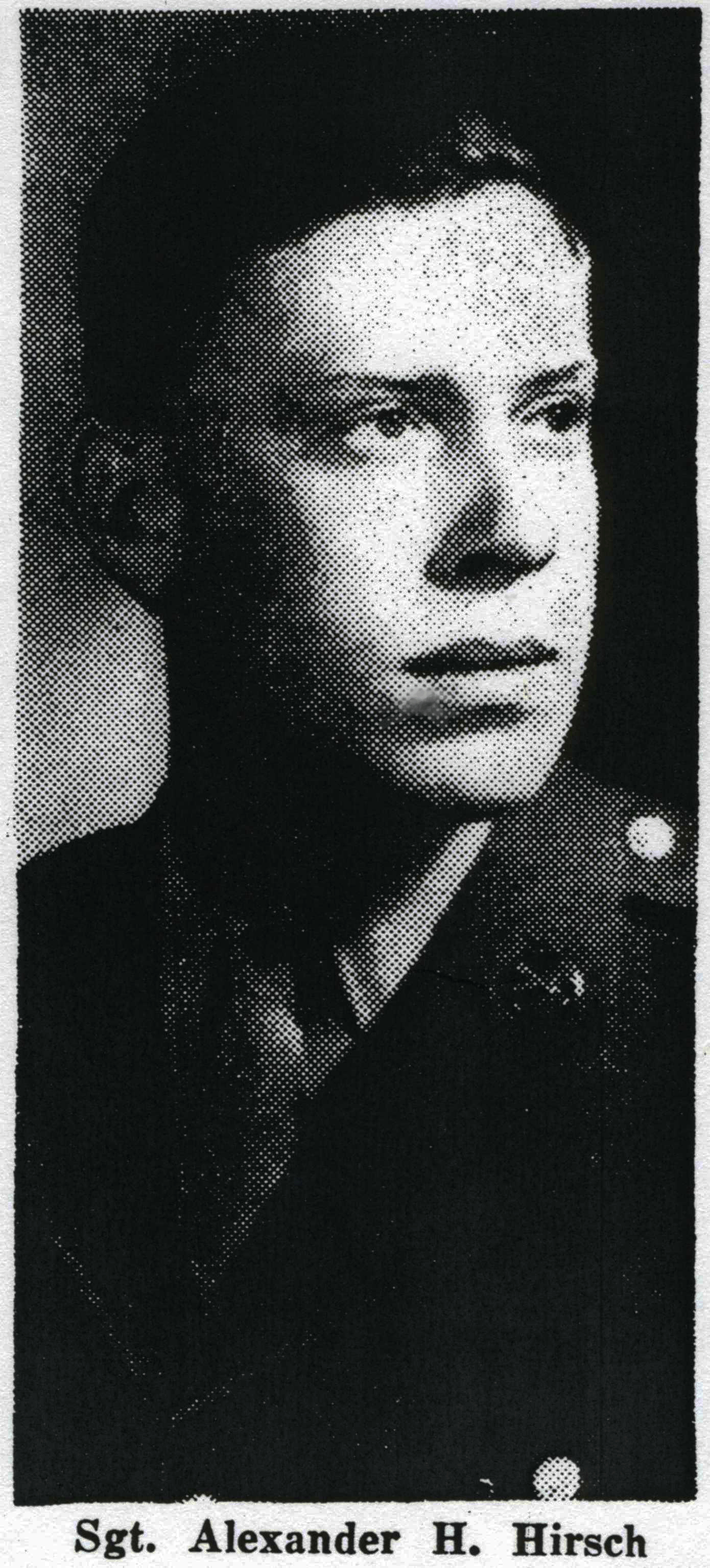 Born in Karlsruhe, Germany, on July 3, 1921, Alexander resided with his uncle Isidore at 22 Central Park South, in Manhattan, seen below.
Born in Karlsruhe, Germany, on July 3, 1921, Alexander resided with his uncle Isidore at 22 Central Park South, in Manhattan, seen below.
 The recipient of the Purple Heart, he is buried at Grave 9135, Section H, of the Long Island National Cemetery, in Farmingdale, N.Y. His name appeared in the Times in an official Casualty List on March 15, and can be found on page 344 of American Jews in World War II.
The recipient of the Purple Heart, he is buried at Grave 9135, Section H, of the Long Island National Cemetery, in Farmingdale, N.Y. His name appeared in the Times in an official Casualty List on March 15, and can be found on page 344 of American Jews in World War II.
(Curiously, though both the Times and Aufbau give Alexander’s surname as “Hirsch”, the surname actually was “Hersh”, which appears in the World War II Honor List of Dead and Missing Army and Army Air Forces Personnel from New York, and, on his matzeva.)
Some other Jewish military casualties on Sunday, January 21, 1945, include the following…
Killed in Action
– .ת.נ.צ.ב.ה. –
Allen, Edwin W., 2 Lt., 0-785157, Bombardier, Purple Heart
United States Army Air Force, 10th Air Force, 7th Bomb Group, 9th Bomb Squadron
Born 1925
Mr. Reuben Allen (father), 4740 Bedford Ave., Brooklyn, N.Y.
No MACR, Aircraft B-24J 42-73311, Pilot 2 Lt. Roy W. Howser, 8 crew – no survivors
Cemetery location unknown
Casualty List 3/20/45
American Jews in World War II – 265
Ben Hammou, Georges Isaac (AC-21P-19263) France (Algeria), (At Region of Schuvergausse, Haut-Rhin, France)
French Army, 9eme Bataillon Médical, 2eme Compagnie de Ramassage
Born January 27, 1923
Algerie, Oran, Perregaux
Place of burial – unknown
____________________
Though the famous T-34 tank is emblematic of the armored forces of the Soviet Union during the Second World War, the U.S.S.R. received 4,102 American M4A2 Sherman tanks via Lend-Lease. Wikipedia entries for the M4 Sherman can be found in English (here), and Russian (here).
One such tank was commanded by Guards Junior Lieutenant [Гвардии Младший Лейтенант] Yakov Moiseevich Blat [Яков Моисеевич Блат] from Proskurov, who was killed in action at Kápolnásnyék, Hungary.
U.S.S.R. [C.C.C.Р.], Red Army [РККА [Рабоче-крестьянская Красная армия]], 1st Ukrainian Front, 1st Guards Mechanized Corps, 2nd Guards Mechanized Brigade, 19th Guards Tank Regiment
Year and Place of Birth: 1921; Proskurov, Kamenets-Podolsk Oblast, Ukraine
Buried 1 km. east of Kápolnásnyék, Hungary.
____________________
Cooper, Fred H., S/Sgt., 39093677, Purple Heart
United States Army
Born 1907
Mr. Morris Cooper (father), 1515 North West Everett St., Portland, Or. / Santa Cruz, Ca.
Ahavai Shalom Cemetery, Portland, Or. – 103, 31
American Jews in World War II – 506
Dement / Diment [Демент / Димент], Moisey Borisovich [Моисей Борисович], Guards Senior Lieutenant [Гвардии Старший Лейтенант]
Tank Commander/ Platoon Commander – T-34 Tank
U.S.S.R. [C.C.C.Р.], Red Army [РККА [Рабоче-крестьянская Красная армия]], 2nd Guards Tank Brigade
Killed in action at Gumbinnen, Prussia
Year and Place of Birth: 1909; Chernivtsi, Ukraine
Gamburg [Гамбург], Lev Zinovevich [Лев Зиновьевич], Private [Рядовой], Sapper [Сапер]
U.S.S.R. [C.C.C.Р.], Red Army [РККА [Рабоче-крестьянская Красная армия]], 181st Tank Brigade
Gelfer, Howard L., Cpl., 32647108, Purple Heart (in Belgium)
United States Army, 30th Infantry Division, 230th Field Artillery Battalion
Born 1921
Mrs. Ada S. Gelfer (mother), 2754 Grand Concourse, Bronx, N.Y.
Long Island National Cemetery, Farmingdale, N.Y. – Section H, Grave 8131
Casualty List 3/8/45
American Jews in World War II – 318
This image of Cpl. Gelfer’s matzeva is by FindAGrave Contributor Maryann.
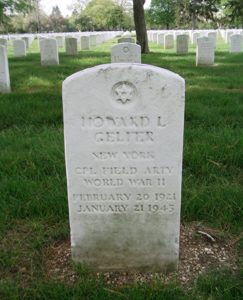 Gelsman, Eugene, 2 Lt., 0-571762
Gelsman, Eugene, 2 Lt., 0-571762
United States Army Air Force, Air Transport Command
Died in a jeep accident in Algeria
Born June 4, 1921
Mr. and Mrs. Harry J. [5/4/92-6/20/72] and Caroline [9/19/95-4/25/57] Gelsman (parents), S/Sgt. Arthur and PFC Norman (brothers), 1611 Nedro Ave., Philadelphia, Pa.
Roosevelt Memorial Park, Trevose, Philadelphia, Pa. – Lot U, Plot 141, Grave 4; Buried 5/30/48
Jewish Exponent 6/4/48
Philadelphia Inquirer 5/29/48
American Jews in World War II – 523
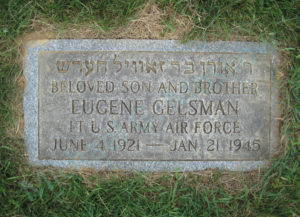 Horowitz, Morris M., Pvt., 32656830, Purple Heart
Horowitz, Morris M., Pvt., 32656830, Purple Heart
United States Army, 94th Infantry Division, 301st Infantry Regiment
Born 1911
Mrs. Rose Horowitz (wife), c/o Fisher, 234 NE 47th St., Miami, Fl.
Luxembourg American Cemetery, Luxembourg City, Luxembourg – Plot A, Row 6, Grave 11
American Jews in World War II – Not listed
Kendall, Milton R., 1 Lt., 0-1303902, Purple Heart (Belgium)
United States Army
Born July 23, 1914
Mr. Abraham S. Kendall (father), 19 Darwood Place, Mount Vernon, N.Y.
Sgt. Irving B. Kendall (brother), Mrs. Jerome J. Slote (sister)
Arlington National Cemetery, Arlington, Va. – Section 12, Grave 2710
Mount Vernon Daily Argus 2/13/45
American Jews in World War II – 361
This image of Lt. Kendall’s matzeva is by FindAGrave Contributor Anne Cady.

Lang, Marvin, PFC, 42024449, Purple Heart
United States Army, 94th Infantry Division, 301st Infantry Regiment, B Company
Born Rochester, N.Y., June 8, 1923
Mr. and Mrs. Charles and Fay Lang (parents), Seymour (brother), 24 OK Terrace, Rochester, N.Y.
Britton Road Cemetery, Rochester, N.Y. – Beth Israel Hock Hochodosh Section; Buried 5/29/49
Casualty List 10/3/45
Rochester Democrat and Chronicle 12/16/45
American Jews in World War II – 371
A photo of PFC Lang’s matzeva, by Robert Coomber, of the Rochester Genealogical Society…
 Levi [Леви], Filipp Semenovich [Филипп Семенович], Junior Lieutenant [Младший Лейтенант]
Levi [Леви], Filipp Semenovich [Филипп Семенович], Junior Lieutenant [Младший Лейтенант]
Tank Commander – T-34 Tank
U.S.S.R. [C.C.C.Р.], Red Army [РККА [Рабоче-крестьянская Красная армия]], 89th Tank Brigade, 3rd Tank Battalion
Lightly wounded in action twice previously [Слегка раненый в действии дважды ранее] – 8/2/42 and 6/25/44
Year and Place of Birth: 1924; Krimskaya ASSR; City of Karasu-Bazar
Levin [Левин], Lev Moiseevich [Лев Моисеевич], Lieutenant [Лейтенант]
Company Commander – Motorized Submachine Gun Battalion [Командир Роты Моторизованного Батальона Автоматчнков]
U.S.S.R. [C.C.C.Р.], Red Army [РККА [Рабоче-крестьянская Красная армия]], 1st Byelorussian Front, 9th Tank Corps, 23rd Tank Brigade
Year and Place of Birth: 1923; Stalinskaya Oblast; City of Nikitovna
____________________
A review of Missing Air Crew Reports for B-17 and B-24 losses of the 8th and 15th Air Forces – as well as personal memoirs and historical literature covering the air war over Europe – reveals that mid-air collisions between heavy bombardment aircraft during combat and training missions were – alas – sadly not uncommon.
On such incident occurred on January 21, 1945, in the skies southwest of Stuttgart, Germany. (Another will be recounted below.)
That day, as covered in Missing Air Crew Reports 11759 and 11760, two Hell’s Angel’s (303rd Bomb Group) Flying Fortresses were lost during the Group’s mission to the marshalling yards at Aschaffenburg. The planes, flying at 23,000 feet, collided at the Group’s turning point, prior to the IP (Initial Point) of the bomb run: The right wing of the aircraft leading the squadron formation (Scorchy II, 42-95078, piloted by 2 Lt. Richard A. Tasker) colliding with the left wing of the lead plane of the second flight (the “un-nicknamed” 44-8137, a radar-equipped pathfinder aircraft piloted by 1 Lt. Richard B. Duffield).
The damaged wings of both planes broke away, and the two aircraft fell to earth. Luftgaukommando Report KU 3625, for 44-8137 (curiously, there appears to be no Luftgaukommando Report for Scorchy II; at least no such document is associated with MACR 11760!) records that the plane (therefore both planes?) crashed 1 kilometer southeast of Lossburg, or, 9 kilometers southeast of Freudenstadt.
Of the twenty men aboard the two aircraft – ten in each plane – only two escaped: 1 Lt. James C. Flemmons, bombardier of 44-8137, and Sgt. Arthur H. Driver, tail gunner of Scorchy II. Sgt. Driver escaped from within the severed tail of Scorchy II only 1,000 feet above the ground, miraculously managing to deploy his partially attached parachute a moment later, for a hard but safe landing. Both he and Lt. Flemmons survived the war as POWs.
The flight engineer of 44-8137 was T/Sgt. Raymond Levine, of the Bronx. On December 7, 1944, only one and a half months prior to her father’s last mission, a photograph of his six-month-old daughter, Susan Roberta, appeared in the New York Post, accompanied by a letter from her mother, Phyllis, found via Thomas Tryniski’s FultonHistory website:
(The following letter and photograph came to The Post from the wife of Technical Sergeant Raymond Levine, gunner on a B-17, who is serving overseas.)
Dear Editor: Will you please published the enclosed picture in your paper, as an inducement to sell war bonds? The baby’s name is Susan Roberta Levine, age six months. – MRS. PHYLLIS LEVINE

Levine, Raymond, T/Sgt., 32422716, Flight Engineer, Air Medal, 3 Oak Leaf Clusters, Purple Heart
United States Army Air Force, 8th Air Force, 303rd Bomb Group, 359th Bomb Squadron
Mrs. Phyllis S. Levine (wife), Susan Roberta Levine (daughter; born July, 1944) 1819 Weeks Ave., Bronx, N.Y.
National WW II Memorial Honoree Record by Grace Weiner
MACR 11759, Luftgaukommando Report KU 3625, Aircraft B-17G 44-8137, Pilot 1 Lt. Richard B. Duffield, 10 crew – 1 survivor (1 Lt. James C. Flemmons, Bombardier)
Lorraine American Cemetery, St. Avold, France – Plot J, Row 43, Grave 17
New York Post 12/7/44
American Jews in World War II – 378
This image of T/Sgt. Levine’s matzeva is by FindAGrave Contributor Suzanne Hye.
While serving on screen and radar picket duty as a part of Fast Carrier Task Group 38.1 of the 3rd Fleet, the destroyer USS Maddox (DD-731) was hit by a Kamikaze suicide-plane (specifically, a Mitsubishi Zero fighter) while off the coast of Formosa. The aircraft, carrying an aerial bomb estimated to have weighed 100 pounds, struck the ship’s starboard superstructure. The explosion and fire killed eight sailors and wounded and thirty-five.
Among the casualties was Seaman Harry Paul, whose name appeared in the Philadelphia Record in mid-March. But – like many Jewish WW II servicemen and military casualties from the Philadelphia area – his name never appeared in The Jewish Exponent. Like many Jewish Philadelphians of that era, he hailed from (south) Philadelphia; in his family’s case, the Whitman section of that city.
Paul, Harry, S1C, 2463835, Seaman, Purple Heart
United States Navy, USS Maddox
Born 1926
Mr. Samuel Paul (father); Jack (brother), 2635 S. 7th St., Philadelphia, Pa.
Tablets of the Missing at Manila American Cemetery, Manila, Philippines
Philadelphia Record 3/14/45
American Jews in World War II – 542
____________________
Two Flying Fortresses were lost in a mid-air collision over Germany, and two other B-17s were similarly lost in the skies of England…
As the 381st Bomb Group returned to its base at Ridgewell from the 8th Air Force’s mission to Aschaffenburg, two aircraft on the base leg of the landing pattern – neither actually with the Group’s formation – were flying between 1,000 and 1,500 feet. B-17G 42-40011 (GD * O, SCHNOZZLE, of the 532nd Bomb Squadron, piloted by F/O Nicholas P. Tauro) attempted to climb over B-17G 42-97511 (MS * K, Egg Haid of the 535th Bomb Squadron, piloted by 2 Lt. James E. Smith) but instead collided with that aircraft. The incident is covered in Missing Air Crew Report 15283.
Both planes fell to earth southwest of the airdrome.
Two Army Air Force images of Schnozzle (named after singer, comedian, and actor Jimmy Durante, and assigned to the 532nd Bomb Squadron almost exactly one year previously) are shown below. The black and white image, photo C-65837AC / A46358, was taken on March 31, 1944, while the Army Air Force color image K2198 is also available via the American Air Museum in England. Also shown is the simple nose art of Egg Haid, photo A-65835AC / A-46348.
 Radio Operator S/Sgt. Morris Shapiro and Navigator F/O Seymour L. Sobole were crewmen aboard SCHNOZZLE. Flight Officer Sobole’s award of the Purple Heart – and no Air Medals – would suggest that he had flown fewer than five combat missions, while S/Sgt. Shapiro had probably flown less than 15.
Radio Operator S/Sgt. Morris Shapiro and Navigator F/O Seymour L. Sobole were crewmen aboard SCHNOZZLE. Flight Officer Sobole’s award of the Purple Heart – and no Air Medals – would suggest that he had flown fewer than five combat missions, while S/Sgt. Shapiro had probably flown less than 15.
Shapiro, Morris A., S/Sgt., 32716674, Radio Operator, Air Medal, 1 Oak Leaf Cluster, Purple Heart
Mrs. Sylvia Shapiro (wife), 1718 Washington Ave., Bronx, N.Y.
Casualty List 3/27/45
Cambridge American Cemetery, Cambridge, England – Plot C, Row D, Grave 24
Brooklyn Eagle 6/20/44
American Jews in World War II – 196, 439
Morris’ matzeva, in a photo by julia&keld…
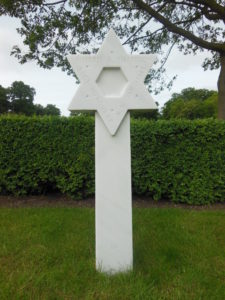 Sobole, Seymour L. (Yekutiel Yehudah Bar Reuben), F/O, T-128479, Navigator, Purple Heart
Sobole, Seymour L. (Yekutiel Yehudah Bar Reuben), F/O, T-128479, Navigator, Purple Heart
Born 1922
Mr. and Mrs. Robert E. [1891-2/21/50] and May Devora [1899-6/28/82] Sobole (parents), 108 Woodmere Ave., Detroit, Mi.
Nusach Harai Cemetery, Ferndale, Mi. – Grave G-184 / Congregation Beth Tefilo Cemetery, Ferndale, Mi. – Section G, Row 2
American Jews in World War II – 196
This image of the matzeva of Seymour and his parents is by FindAGrave contributor Gilly.
Stone, Leonard Alfred, Trooper, 6027261, England
British Army, 141st Regiment (7th Buffs)
Born 1913
Mrs. Harriet Stone (wife), Whitechapel, London, England
Sittard War Cemetery, Limburg, Netherlands – K,15
We Will Remember Them – A Record of the Jews Who Died in the Armed Forces of the Crown 1939 – 1945 – 166
Tibber, Jack, Pvt., 13085593, England
British Army, Pioneer Corps
Born 1906
Mrs. Eva Tibber (wife), 10 Chester House, 130 New Cavendish St., Marylebone, London, W1, England
Mr. and Mrs. Morris and Anne Tibber (parents)
The Jewish Chronicle 2/16/45
Schoonselhof Cemetery, Antwerpen, Belgium – V,A,90
We Will Remember Them – A Record of the Jews Who Died in the Armed Forces of the Crown 1939 – 1945 – 170
Weiner, Morris, Pvt., 32413350, Purple Heart
United States Army, 2nd Infantry Division, 23rd Infantry Regiment
Born 1921
Mr. Harry Weiner (father), 370 S. 2nd St., Brooklyn, N.Y.
Long Island National Cemetery, Farmingdale, N.Y. – Section H, Grave 10425
Casualty List 3/14/45
American Jews in World War II – 467
Zaltsman / Zaytsman [Зальцман / Зайцман], Petr Abramovich [Петр Абрамович], Senior Technician-Lieutenant [Старший Техник-Лейтенант]
Deputy Company Commander – Technical Section [Заместитель по Технический Части Командира Роты]
U.S.S.R. [C.C.C.Р.], Red Army [РККА [Рабоче-крестьянская Красная армия]], 181st Tank Brigade, 3rd Tank Battalion
Year and Place of Birth: 1919; Mohyliv-Podilsky, Vinnytsia Oblast
Buried at Sóskút, Hungary
____________________
United States Navy
Aboard the Aircraft Carrier USS Ticonderoga (CV-14)
The destroyer USS Maddox was not the only United States Navy ship that was struck by Kamikaze aircraft on the twenty-first of January. The aircraft carrier USS Ticonderoga, part of Task Force 38, was among the Task Force’s three Task Groups whose aircraft struck airfields on Formosa, in the Pescadores (an archipelago of islands west of Taiwan, in the Taiwan Strait), and at Sakashima Gunto (an archipelago at the southernmost end of the Japanese archipelago).
The carrier was struck by two Kamikaze aircraft. The first crashed through the ship’s flight deck and exploded just above the hangar deck, killing men and destroying several aircraft. Damage was kept under control under the directions of Captain Dixie Kiefer, who, by changing the ship’s course and selectively flooding magazines and other compartments, induced a list which eventually dumped the fire overboard.
The ship then underwent an attack by four more Kamikazes. Three were shot down into the sea, but the fourth impacted the carrier’s starboard side near the island, the explosion of the plane’s bomb and the resulting fires killing a further 100 crewmen and injuring others, among the latter Captain Kiefer. The fires were brought under control not long after two in the afternoon, and the ship retired, reaching Ulithi (in the Caroline islands) three days later.
The impact of the second kamikaze can be seen in this film, which clearly shows the ship’s list.
According to the Aviation Archeology database, the Kamikaze attacks on the Ticonderoga resulted in the loss of 31 F6F Hellcats fighters, 4 SB2C Helldiver dive-bombers, and 5 TBM Avenger torpedo-bombers. A solitary Helldiver and a single Avenger were also lost during combat missions that day, with their crews having been rescued.
The following three films show the results of the kamikaze strikes on the Ticonderoga.
The first film, from the YouTube channel of Colonel Tannenbusch, very clearly shows the impact of one of the Kamikazes (at 0:24) upon the Ticonderoga, and, from 0:51 to 1:14, the list by which Captain Kiefer was able to control the fire.
The second film, recorded shortly after the ship was struck by (probably…) the second Kamikaze, shows (from 0:00 to 8:40) damage to the ship, the crew’s efforts to contain and control fire raging on and within the ship’s flight and hangar decks, and efforts to aid wounded crewmen. The remainder of the film shows damage to the hangar deck, a damaged Hellcat fighter, and the jettisoning of Hellcat from the flight deck. Produced on January 29, 1945, the film was discovered at the WWIIPublicDomain YouTube channel, having first been uploaded to the Internet Archive. (The film is Naval Photographic Center film 428-NPC-6982 (local identified 428-NPC-6982; United States National Archives Identifier 77925.)
The third film, produced on November 21, 1945, shows battle damage to the flight deck and island of the Ticonderoga, and, the jettisoning of damaged aircraft into the waters of the Pacific.
Scenes are the following:
0:09 – 0:31: Flight deck and island of the carrier.
0:32 – 0:51: A damaged F6F Hellcat is jettisoned from the carrier’s deck. Notice the damage to the aircraft’s wing from the heat of the fire.
0:52 – 1:01: Damaged to the carrier’s island.
1:02 – 1:04: Another aircraft is jettisoned.
1:05 – 1:47: Closer views of damage to the island.
1:48 – 2:48: Another Hellcat is jettisoned, albeit leaving the ship with tremendous reluctance.
The film was also discovered at the WWIIPublicDomain YouTube channel, also having first been uploaded to the Internet Archive. (The film is Naval Photographic Center film 428-NPC-6981 (local identified 428-NPC-6981; United States National Archives Identifier 77924.)
Killed in Action aboard the USS Ticonderoga
– .ת.נ.צ.ב.ה. –
Lifland, Bernard, S1C, 9221115, Seaman, Purple Heart
Mrs. Grace Catherine Lifland (wife), 316 N. 9th St., Allentown, Pa.
Tablets of the Missing at Manila American Cemetery, Manila, Philippines
American Jews in World War II – 536
Maher, Miles Morris, S1C, 7123151, Seaman, Purple Heart
Mrs. Rose Maher (mother), 1627 York Ave., New York, N.Y.
Tablets of the Missing at Manila American Cemetery, Manila, Philippines
American Jews in World War II – 385
Wounded or Injured aboard the USS Ticonderoga
Kaufman, Harold Bernard, RT2C, Radio Technician, 7099966, Purple Heart
Mr. B. Kaufman (father), 892 Bergen St., Brooklyn, N.Y.
Casualty List 4/30/45
American Jews in World War II – 359
Shestack, Jerome Joseph (“Jerry”), Ensign or Lieutenant, Gunnery Officer, 0-256022, Purple Heart
Born Atlantic City, N.J., February 11, 1923; Died August 18, 2011
Mr. and Mrs. Isadore and Olga Shestack (parents), 5452 Lebanon Ave., Philadelphia, Pa.
Philadelphia Inquirer 8/20/11
American Jews in World War II – Not Listed
A candid image of Jerome Shestack, from the Remembering Jerome J. Shestack (Gallery).
Prisoners of War
Applestine, Bernard, PFC, 33001573
United States Army, 30th Infantry Division, 120th Infantry Regiment
Prisoner of War at Stalag 12A (Limburg an der Lahn, Germany)
Born Maryland, December 19, 1918
Mr. and Mrs. Simeon and Rose H. (Miller) Applestine (parents), 3012 W. Garrison Ave., Baltimore, Md.
American Jews in World War II – Not listed
Artin, Philip, Pvt., 42138150
United States Army, 45th Infantry Division, 157th Infantry Regiment
Prisoner of War at Stalag 11B (Fallingbostel, Germany)
Born New York, February 16, 1919
Mrs. Rose Artin (wife), 2114 Mapes Ave., Bronx, N.Y.
American Jews in World War II – Not listed
Barlas, Benjamin, Pvt., 42138568
United States Army, 45th Infantry Division, 157th Infantry Regiment
Prisoner of War at Stalag 11B (Fallingbostel, Germany)
Born New York, 1923
Mr. and Mrs. Mordecai and Bella Barlas (parents), Dora (sister), 1817 Tenth Ave., Bronx, N.Y.
Casualty List 4/20/45
American Jews in World War II – Not listed
Cohn, Albert D., Pvt., 13126322
United States Army, 94th Infantry Division, 301st Infantry Regiment
Prisoner of War at Stalag 11B (Fallingbostel, Germany)
Born Pennsylvania, December 14, 1922
Mr. and Mrs. Samuel and _____ (Shander) Cohn (parents), 5443 Wyndale Ave., Philadelphia, Pa.
American Jews in World War II – Not listed
Fiman, Meyer, PFC, 37639179
United States Army, 45th Infantry Division, 157th Infantry Regiment
Prisoner of War at Stalag 12A (Limburg an der Lahn, Germany)
Born Missouri, April 4, 1912
Mr. and Mrs. Henry and Sylvia (Ratner) Fiman (parents), 1615 South Jefferson Ave., St. Louis, Mo.
(also) 5718 Waterman Blvd., St. Louis, Mo.
Saint Louis Post Disptach 2/15/45
American Jews in World War II – Not listed
Fineblum, Solomon S., PFC, 33731236
United States Army, 94th Infantry Division, 301st Infantry Regiment, A Company
Prisoner of War at Stalag 11B (Fallingbostel, Germany)
Born Maryland, April 21, 1925
Mr. and Mrs. Morris and _____ (Rochlin) Fineblum (parents), Pvt. Jerome Fineblum (brother), 2501 Manhattan Ave., Baltimore, Md.
WW II Memorial Honoree Record by his friend, Chet Obukowicz
Jewish Times (Baltimore) 5/4/45
American Jews in World War II – Not listed
Friedman, Abraham J., PFC, 33386834
United States Army, 94th Infantry Division, 301st Infantry Regiment
Prisoner of War at Stalag 12A (Limburg an der Lahn), and, Stalag 11B (Fallingbostel, Germany)
Born Maryland, July 27, 1915
Mrs. Nettie (Goldiner) Friedman (mother), 1618 McKean Ave., Baltimore, Md.
American Jews in World War II – Not listed
Kaplan, Milton, PFC, 32598178
United States Army, 94th Infantry Division, 301st Infantry Regiment
Prisoner of War at Stalag 11B (Fallingbostel, Germany)
Born New Jersey, September 8, 1920
Mrs. Sarah Kaplan (mother), 126 Ridgewood / 507 Belmont Ave., Newark, N.J.
Casualty List 6/25/45
American Jews in World War II – Not listed
Kaplan, Robert J., S/Sgt., 35146114
United States Army, 45th Infantry Division, 157th Infantry Regiment
Prisoner of War at Stalag 12A (Limburg an der Lahn, Germany)
Born Indiana, February 16, 1925
Mr. and Mrs. Ralph and _____ (Risman) Kaplan (parents), 612 Cleveland St., Garry, In.
WW II Honoree Record by “Susie, Steve, Nancy, Jim, Brian and Michael, Children and Grandchildren”
American Jews in World War II – Not listed
Novick, Alvin, PFC, 42037918, Purple Heart
United States Army, 94th Infantry Division, 301st Infantry Regiment
Prisoner of War at Stalag 11B (Fallingbostel, Germany)
Born June 27, 1925
Mr. and Mrs. Irving (“Isidore”) and Lena (Janowitz) Novick (parents), Rosalind Novick (sister), 145-11 33rd Ave., Flushing, N.Y.
Studied Physics at Columbia University
Long Island Star Journal 5/22/45
American Jews in World War II – 400
____________________
Shapiro, Seymour, Pvt., 32649328, Purple Heart
United States Army, 45th Infantry Division, 157th Infantry Regiment
Prisoner of War at Stalag 11B (Fallingbostel, Germany); German POW Number 99435
Born New York, April 4, 1922
Mr. and Mrs. Samuel and Millie (Deskin) Shapiro (parents), 665 Riverdale Ave., Brooklyn, N.Y.
American Jews in World War II – 62
Private Shapiro’s German POW Personalkarte (Personal Card) found in the National Archives, is shown below. Though Personalkarte forms allocate a space for a POW’s identification (“mug shot”) photograph, the great majority of forms for American POWs at Stalag 11B lack such photographs.
Shindel, Solomon, Cpl., 36852136, Ball Turret Gunner, Air Medal, 2 Oak Leaf Clusters, Purple Heart
United States Army Air Force, 8th Air Force, 486th Bomb Group, 833rd Bomb Squadron
Wounded; Prisoner of War (camp unknown)
MACR 11798, Luftgaukommando Reports KU 3602 and KU 3627, Aircraft B-17G 43-38925 (4N * T), Pilot 1 Lt. George W. Holdefer, 9 crew – all survived
Born May 5, 1919
Mrs. Sylvia Tutnick (sister), 17159 Greenlawn St., Detroit, Mi.
Casualty List 6/20/45
American Jews in World War II – 196
Shocket, Murray, Cpl., 42036772
United States Army, 45th Infantry Division, 157th Infantry Regiment
Prisoner of War at Stalag 12A (Limburg an der Lahn, Germany)
Born August 17, 1920
Mr. and Mrs. Michael and Gloria (Fink) Shocket (parents), 313 S. 5th St., Brooklyn, N.Y.
American Jews in World War II – Not listed
Solomon, Isaac, PFC, 42055485, Purple Heart
United States Army, 45th Infantry Division, 157th Infantry Regiment
Prisoner of War at Stalag 11B (Fallingbostel, Germany)
Born New York, April 26, 1925
Mr. and Mrs. Max and S. (Sidransky) Solomon (parents), 190 E. 52nd St., Brooklyn, 3, N.Y.
American Jews in World War II – 419
Weingarten, Sol, PFC, 42034540
United States Army, 94th Infantry Division, 301st Infantry Regiment
Prisoner of War at Stalag 11B (Fallingbostel, Germany)
Born New York, 1923
Mr. and Mrs. Benjamin and Estelle Weingarten (parents), Anna, Bertha, and Moses (sisters and brother), 1496 Flatbush Ave., Brooklyn, N.Y.
Casualty List 4/20/45
American Jews in World War II – Not listed
Wounded in Action
Three Jewish aviators who were killed during combat missions – T/Sgt. Raymond Levine, S/Sgt. Morris A. Schwartz, and F/O Seymour L. Sobole – have been mentioned above.
Two other Jewish Eighth Air Force fliers were also casualties on this day, but – both wounded – survived the war. Coincidentally, they served in the same Bombardment Group (the 486th), in the same squadron (the 835th), and – as pilot and co-pilot of a Flying Fortress – within the cockpit of the same plane: B-17G 44-8615, otherwise known as Mary Lou (H8 * G).
They were Gerson Bacher and Nathan Spungin.
The aircraft was struck by a burst of flak during the 486th’s mission to Mannheim, Germany, shrapnel and debris from which blinded Lt. Bacher and severely injured Lt. Spungin’s legs. Sharing control of Mary Lou, with Lt. Spungin manipulating the bomber’s control column and Lt. Bacher the aircraft’s rudder pedals, they brought the damaged plane back to a safe landing at Sudbury, England.
According to the 486th Bombardment Group Website, besides Lt. Spungin, Lieutenant Bacher’s crew consisted of:
Navigator (Dead-Reckoning): Lt. Charles Monk
Navigator (Radar): Lt. Walter Dinwiddie
Bombardier: Lt. George “Pop” Edgar
Flight Engineer: T/Sgt. Charles “Blink” Blankenship
Radio Operator / Waist Gunner: T/Sgt. Alfred “Beam” Bain
Ball Turret Gunner: S/Sgt. Paul “Shorty” Bolduc
Waist Gunner: S/Sgt. William Curtis
Tail Gunner: S/Sgt. Albin “Red” Markiewicz
A (copyrighted, that’s why I’m linking to it!) image of the crew can he found here…
…while a list of the crew’s missions appears here…
…and Lieutenant Edgar’s diary of the crew’s missions (extending beyond January 21, 1945) can be read here…
…with images of Mary Lou here and here.
The incident was briefly covered by the Associated Press, and in greater detail by the newspapers respectively serving Bayonne, New Jersey, and Harrisburg, Pennsylvania, for Bacher and Spungin. They flew no further combat missions.
Also notable is his Lt. Bacher’s pre-war vocation: He was a welder: A reminder of an age in which the value – moral as much as purely economic – of vocational trades was not obscured by the near-monolithic (and continuing, but eventually dissolving) primacy of academic credentials in post WW II America.
(But, that’s another subject!)
United States Army Air Force, 8th Air Force, 486th Bomb Group, 835th Bomb Squadron
Pilot and Co-Pilot – Both wounded
Aircraft B-17G 44-8615 (“H8 * G”, “Mary Lou”) – entire crew survived
News Item 3/5/45
Bacher, Gerson “Bach”, 1 Lt., 0-798231, Bomber Pilot, Silver Star, Air Medal, 2 Oak Leaf Clusters, Purple Heart, completed 22 combat missions
Born Harrisburg, Pa., October 11, 1920; Died March 15, 1989
Mrs. Mildred (Fastov) Bacher (wife), 399 Avenue C, Bayonne, N.J.
Mrs. Ruby Cohen (mother), 1132 Boulevard, Bayonne, N.J.
American Jews in World War II – 226
Spungin, Nathan “Sponge”, 1 Lt., 0-825704, Co-Pilot, Air Medal, 2 Oak Leaf Clusters, Purple Heart, completed 21 missions
Born Harrisburg, Pa., 10/11/20
Mrs. Elaine Ruth (Morris) Spungin (wife), Patricia Ann, Barbara Jean, and Janis Louise (daughters), 2801 Morgan St., Tampa, Fl.
Mr. and Mrs. Samuel and Fannie Spungin (parents), 2911 North Second St., Harrisburg, Pa.
Harrisburg Telegraph 12/30/44, 5/11/45
The Evening News (Harrisburg) 7/9/44, 2/19/45, 5/9/45
American Jews in World War II – 555
This pair of portraits show Lieutenants Bacher (left) and Spungin, the former image from a Bayonne newspaper and the latter from Nathan Spungin’s William Penn High School 1938 class yearbook. (Thanks, Ancestry.com!)
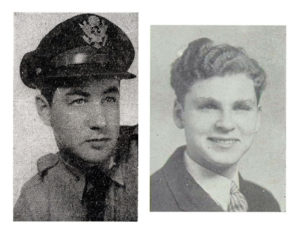 Transcribed newspaper articles about the incident, found at FultonHistory, follow…
Transcribed newspaper articles about the incident, found at FultonHistory, follow…
They Swapped Eyes and Legs
Albany Times-Union
1945
When a burst of Nazi flak all but tore the nose off a flying fortress, the bomber’s pilot, Lieut. Gerson Bacher, was blinded and his co-pilot, Lieut. Nathan Spungin, had a leg ripped off. [Update, November, 2020: According to a recent communication from Nathan’s daughter Janis, her father did not lose his leg. Though he eventually recovered, he carried a scar from the incident for the rest of his life.]
Despite their injuries, the pair carried on in the best Air Force tradition.
Refusing sedatives, the wounded men headed the big ship back for its home field in England. Spungin, unable to take over the controls with only one leg, literally lent his eyes to Bacher, who depended on his co-pilot to tell him when to go up or down, to the right or left.
They brought the battered plane in to a perfect landing by one of the most heroic examples of teamwork in this toughest of all wars.
Blinded Bayonne Boy Flies Plane Safely Home
New York Post
February 19, 1945
A U.S. 8th Air Force Station in England, Feb. 19 (AP) – Lt. Gerson Bacher, 339 Avenue C, Bayonne, N.J., pilot of a Flying Fortress, was temporarily blinded in a recent raid on one [of] Mannheim’s railyards by a burst of flak which tore the nose from the plane, but he and his co-pilot, Lt. Nathan Spungin, Tampa., Fla., who was badly wounded in the leg by flak, teamed up to bring the ship home safely.
With Spungin “calling the plays,” Bacher, blinded by splinters, worked the rudder controls with his feet and they got the big ship back to its base without further mishap. Both are recovering from their wounds.
Bayonne Flier Bombed Nazi Target Despite Loss of Fortress Engine
(Unidentified Newspaper)
December 30, 1944
Though he was unable to keep up with his Eighth Air Force formation, 2nd Lt. Gerson Bacher, 25, pilot, of Bayonne, flew his damaged B-17 Flying Fortress to a successful bombing of an active Luftwaffe base. He and his crew returned safely to England from the recent attack, despite threatening enemy fighters.
Well into Germany, Lt. Bacher’s Fort lost an engine. The loss of power prevented him from continuing on with his group, so he turned away to seek a closer target.
After considerable searching, the crew discovered a Nazi fighter base. The target was partly covered with scattered clouds, but by making a short bomb run, the bombardier centered the target in his bombsight and dropped every bomb on the airfield.
As they turned away from the bombing, rockets shot past them – but not hitting the plane. Two twin-engined fighters streaked out of the clouds, making straight for the Fort’s tail. The tail gunner and the top gunner opened fire on the Nazis, but the planes suddenly veered off to the side.
A swarm of P-51 Mustangs had “appeared out of nowhere” and was blasting the enemy fighters away. Later the tail gunner saw one of the German planes go down in flames.
Lt. Bacher, holder of the Air Medal, is the son of Mr. and Mrs. R. Cohn. His wife, Mildred Bacher, lives with his parents at 399 Avenue C. Before entering the AAF in May, 1941, he was a welder for the General Motors Corp., Linden.
The airman is a member of the 486th Bomb Group.
According to Lieutenant Edgar’s diary, the above incident occurred on December 6, 1944, during a mission to Meresburg, Germany. As he recorded, “When we reached the Hanover area a supercharger went out, and the engine was not much good to us from then on. Unable to keep up with the formation we decided to turn back. Only at times could we see the ground because of heavy clouds. While hunting for a good break in the things so we could make a bomb run on the Ems Canal our pin point navigator sighted an airfield. I didn’t have time to use our bombsight so I dropped my bombs from 22,000 ft. just estimating the release point. Luckily about six of them messed up one of the Luftwaffe’s runways. We had been flying around so long with our doors open they froze open, and we were in the process of cranking them closed when we saw two ME 210’s getting ready to start making passes at us. Just as the first one started his pass about five P-51’s appeared out of nowhere, and we last saw them all diving hell-bent for the clouds. This was the first time I saw any enemy fighters.”
Here is Lt. Edgar’s account of the events of January 21: Once more the air forces were called on to give support to the ground troops, this time we were going to the rail yards at Mannheim. This city was also a nice nest of flak guns. It was planned that we would bomb “Cat and Mouse” so as to avoid the heavy anti-aircraft fire around Karlsruhe. On the bomb run, which took us right up the Rhine Valley, the lead ship’s blind bombing equipment went out making it necessary to make a straight run on the target. The whole group went right over Karlsruhe, and they were good shots down there. Halfway down the bomb run a burst went off right over our nose. A large piece of flak came through the nose taking out my gunsight and barely missing my head. I was afraid to look around at Dinwiddie because he had always been in the habit of standing right behind me on the bomb runs. This day he stayed lying on the floor, and it was a good thing. The piece of flak went through the instrument panel in the cockpit and sprayed tachometers, and glass all over it. One of the oil pressure instruments hit Spungin in the leg, and made a nice hole in it for him. Bacher got some plexiglass in his eyes, and couldn’t see very well. As soon as I dropped our bombs and had the doors closed, I went back, and gave Spungin first aid. As soon as it was possible we left the formation, and with plane on automatic pilot we went on back to the base alone. Bach and Spungin and both received the Purple Heart, as did seven other men in our squadron from that day, and later General Partridge (Division Commander) presented Bach with the Silver Star. After that we all went to the flak house for a rest, and Bacher and Spungin were sent home.
Injured Flier Lands Plane
(Unidentified Newspaper)
February 26, 1945
Blinded temporarily by the flak that ripped through the nose of a Flying Fortress during an attack on Mannheim, January 21, Lt. Gerson Bacher, 25, of 399 Avenue C, managed to reach England safety with the aid of his co-pilot.
Shell splinters blinded Bacher and cut through the co-pilot’s leg. Despite the wound the co-pilot took over the hand controls, calling out orders so that Bacher could work the rudder controls with his feet. Both were sent to a hospital in England for treatment.
Another incident proving Bacher’s courage took place this winter when he was flying with the 8th Air Force over Germany. Unable to keep up with the other planes, this airman flew his damaged B-17 to a successful bombing on active Luftwaffe base.
Holder of the Air Medal, the Lieutenant is a member of the 486th Bomb Group, cited by the President for the England-Africa shuttle bombing of Messerschmitt plants at Regensburg, Germany. [Error! – The article is referring to the Schweinfurt-Regensburg mission of August 17, 1943. The 486th’s first mission occurred on May 7, 1944, over eight months later.] At the time of his last trip he was finishing his 20th mission.
Son of Mr. and Mrs. Ruby Cohn, of 1132 Boulevard, Bacher has been married for three years to Mildred Bacher who lives with her parents, Mr. and Mrs. Gus Fastov, at 399 Avenue C. He was employed as a welder with General Motors Corp., Linden prior to joining the Army in May, 1941.
Service News
(Unidentified Newspaper)
May 29, 1945
Lt. Gerson Bacher, returnee veteran of air combat with the England-based Eighth Air Force as pilot of a B-17, is now stationed at Boca Raton Army Air Field, a technical school of the AAF Training Command. Foer his meritorious service he wears the Silver Star, the Air Medal with two Oak Leaf Clusters and the Purple Heart.
He flew 20 combat missions, totaling 200 combat hours, before being wounded. A graduate from Bayonne High School, Lieutenant Bacher is the son of Mr. and Mrs. R. Cohn, 1132 Blvd., Bayonne. His wife resides at 399 Avenue C.
Another account of the story can be found at the 486th Bomb Group’s website.
________________
Ehrlich, Maxim E., Pvt., 13151212, Purple Heart (Luxembourg)
United States Army
Mr. and Mrs. William T. and Gladys B. Ehrlich (parents), 112 S. 49th St., Philadelphia, Pa.
Philadelphia Record 3/13/45
American Jews in World War II – 518
Paraf, Alexis, Aspirant, Char (Chef de Section), Croix de Guerre (At Cernay, France)
French Army
Wounded; Wounded subsequently – on 1/26/45
On January 20 and 21, 1945, before Cernay, he admirably trained his section on the attack. He counter-attacked in flat terrain; fired anti-tank grenades at short range on enemy tanks. Wounded in the face, would not abandon the battle. Was seriously wounded on 26 January by shelling. [Les 20 et 21 janvier 1945 devant Cernay, a entrainé admirablement sa section à l’attaque. Contre-attaque en terrain plat, a tiré des grenades anti-chars à courte distance sur des blindés ennemis. Blessé à la face, ne voulut pas abandonner le combat. A été sérieusement blessé le 26 janvier par éclat d’obus.]
Livre d’Or et de Sang – Les Juifs au Combat: Citations 1939-1945 de Bir-Hakeim au Rhin et Danube – 196
________________
Evaded Capture After Crash-Landing in Yugoslavia
A notable aspect of 15th Air Force B-17 and B-24 losses during combat missions over eastern and southeastern Europe, especially towards the war’s end, was the frequency with which bomber crews, in part and oftimes in entirety, were able to escape capture and (eventually!) return to American military forces. This occurred with the aid of Partisan forces, civilians, and sometimes after landing in Soviet-controlled territory. The MACRs covering such losses describe the “route” of the return of such airmen in varying detail. Some denote the return of crewmen with the simple acronym RTD (“Returned to Duty”) next to an aviator’s name, while other reports contain perfunctory postwar statements by former crew members.
In the case of a 483rd Bomb Group B-17 lost over the former Yugoslavia on January 21, a substantive account of the crew’s return appeared 29 years after the war, in an Associated Press news story. It was revealed that the aircraft, B-17G 44-6423, piloted by 1 Lt. Robert M. Grossman, crash-landed in a valley north of Banja Luka after a mission to the Lobau Oil Refinery, at Vienna. The entire crew were escorted by Chetniks to the village (hamlet? crossroad?) of “Celiac” (probably Celinovac), where they were sheltered and hidden from capture by the family of Dragutin and Vasilia Cvijanovich. In April, the crew returned to American military control in Italy through the aid of Communist partisans.
Postwar statements by four of the bomber’s crewmen give highly varied locations for the place of the bomber’s landing. These are: 1) 3 miles northeast of Banja Luka (Grossman), 15 miles north of Banja Luka (Keane), 10 km north and a little west of Banja Luka at 45-5 N, 17-10 E (Daniels), and 15 km north of Banja Luka (LeClair).
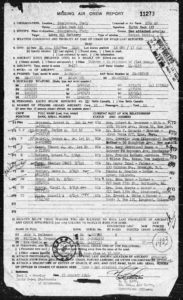
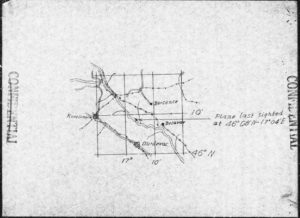 ______________________________
______________________________
Banja Luka, in Bosnia-Herzegovina.
 ______________________________
______________________________
The area north of Banja Luka (red oval) where 44-6423 was probably belly-landed by Lt. Grossman. (Do any remnants of the plane still exist?)
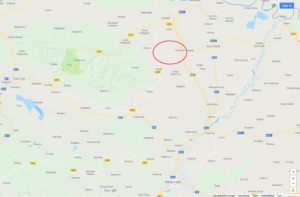 ______________________________
______________________________
Zooming in on the above image, with Celinovac denoted by the red oval.
 ______________________________
______________________________
A Google Earth CNES view of the above area (at the same scale), with Celinovac again denoted in red. (Note the faint gray “line” running southeast to northwest, adjacent to Celinovac…)
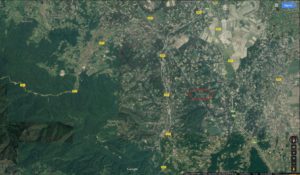 ______________________________
______________________________
A much closer view, showing Celinovac, which essentially is a small group of homes at a cross-road. (The gray “line” referred to above is revealed to be an aircraft contrail!)
 ______________________________
______________________________
The occasion for the AP story was a reunion of four of aircraft 423’s crewmen (Stanley Taxel, (1 Lt. – Navigator) George A. Daniels, Jr., (S/Sgt. – Tail Gunner) Russell A. White, and (S/Sgt. – Left Waist Gunner) James R. Gourley) with Dragutin and Vasilia, at the home of their son Momchilo in Dutchess County, New York. The AP articles are presented below.
Lifesaver Honored at Special Reunion
The Batavia Daily News
February 12, 1974
WAPPINGERS FALLS, N.Y. (AP) – Stanley Taxel, a Manhattan stationery manufacturer, has been reunited with an 80-year-old man who saved his life and the lives of 11 other Americans in Yugoslavia 29 years ago.
The reunion Saturday with Dragutin Cvijanovic took place in this Dutchess County community at the home of Dragutin’s son, Momchilo. The younger Cvijanovic was brought to the United States in 1959 chiefly through Taxel’s efforts.
The elder Cvijanovic sheltered Taxel and the rest of this 10-man B-17 bomber crew after they were shot down during a World War II mission in January 1945.
Taxel and the rest of the crew were found by the Cetniks [sic], an underground group loyal to the Allies, after the plane crash-landed in a mountain range in Yugoslavia.
“We were on our 48th mission,” Taxel said. “I would have had two more missions and I could have gone home. As it turned out, I’m glad we were shot down over Yugoslavia.”
The Cetniks brought the bomber crew to the village of Celinak [sic]. It was there that the crew found a home with the Cvijanovics.
Momchilo was only 10 when his father offered the Americans a home during the war. Today he has only vague recollections of the event that brought his family guests for the winter.
“I remember building a snowman with the Americans,” Momchilo said. “And I remember sleeping on my father’s feet to keep him warm.”
Eventually two more Americans parachuted behind the German lines, and the Cvijanovics’ household grew to 12 American soldiers in addition to Dragutin, his wife and their six children.
“It was the burden of feeding that became the most difficult,” Taxel said. “This man laid it all on the line for us, his wife and the lives of his family.”
Once he returned to the United States, Taxel kept in close contact with Cvijanovics and was eventually responsible for Momchilo’s migration to this country in 1969.
Dragutin recently emigrated to the United States.
“Today,” Taxel said, “I rely very heavily on the experience with the Cvijanovics. When things get very heavy for me, I think back to the mountains and I remember Dragutin.”
Taxel paused and hugged the old man who cannot speak English. “It’s so good to see him again,” he said.”
Tears Mark Reunion of Cvijanovich and the GIs He saved
Cortland Standard
June 19, 1974
By PAUL STEVENS
Associated Press Writer
WAPPINGERS FALLS, N.Y. (AP) – For a moment, tears filled the eyes of the old Yugoslav man as he watched the festive reunion of his sons and the American airmen he sheltered nearly 30 years ago.
“It still seems like they’re my sons,” said Dragutin Cvijanovich, 80. “I always had a feeling that way… There’s no doubt in my mind and heart that it’s the happiest day of my life.”
During World War II, while German soldiers roamed the Yugoslavian countryside, 10 American airmen broke bread with Cvijanovich and his wife and their seven children.
So this weekend was a time for remembering at the homes of Dragutin’s sons, Momchilo and Milorad, who he and his wife, Vasilia, 81, have been visiting from their home in Banja Luka, Yugoslavia.
Only four of the airmen taken in by the Cvijanoviches were able to attend. But the atmosphere was drastically different from the time in 1945 when they sat down with the family to share a single chicken.
American and Yugoslavian flags flew side by side Saturday at Momchilo’s home here. An accordionist played Old World polkas as well as pop tunes. A pig and a lamb were roasted on an open outdoor pit.
The wine flowed freely, so did the memories.
One of the airmen, Stanley Taxel, 51, of New York City, nodded toward the elder Cvijanovich and said, “He’s the guy who saved our lives. This old man…put his neck on the line for us.”
Taxel was one of 10 crew members of a B-17 which was crippled by flak on a mission over Vienna and forced to crash-land near the Cvijanoviches’ home.
“We were bombing an oil refinery on the Dabube,” recalled George Daniels of Stamford, Conn., the plane’s navigator. “We lost an engine and had to come down when the fuel was running out.”
The plane landed smoothly on the heavy snowfall in January 1945 and the men were quickly whisked away by the Chetniks, a guerilla group, who took them to the Cvijanoiches’ home in Celniac.
Dragutin, his wife and seven children slept in a bedroom and an outside shed while the airman occupied the other bedroom in the farmhouse. When Germans would come to the home, Taxel recalled, the men were taken into the mountains to safety.
Mrs. Cvijanovic stretched the limited food supply.
“She was a crackerjack,” said Taxel. “There was little food. Everyone was starving – we ate rotten goat meat at times. She knew how much food to dole out to keep people alive.”
In April, Communist partisans helped the men to escape through the mountains to Italy, where the 15th Air Force was headquartered.
Most of the men had not seen the Cvijanoviches since. But Russ White of Denver, who came here from Colorado with fellow airman James Gourley of Two Buttes, said time hadn’t blotted his memory. “I would know them anywhere.”
Here is Stanley Taxel’s 1941 Erasmus Hall High School graduation portrait, while this AP image, from The Evening News (Dutchess County), shows Stanley and Dragutin during their 1974 reunion.
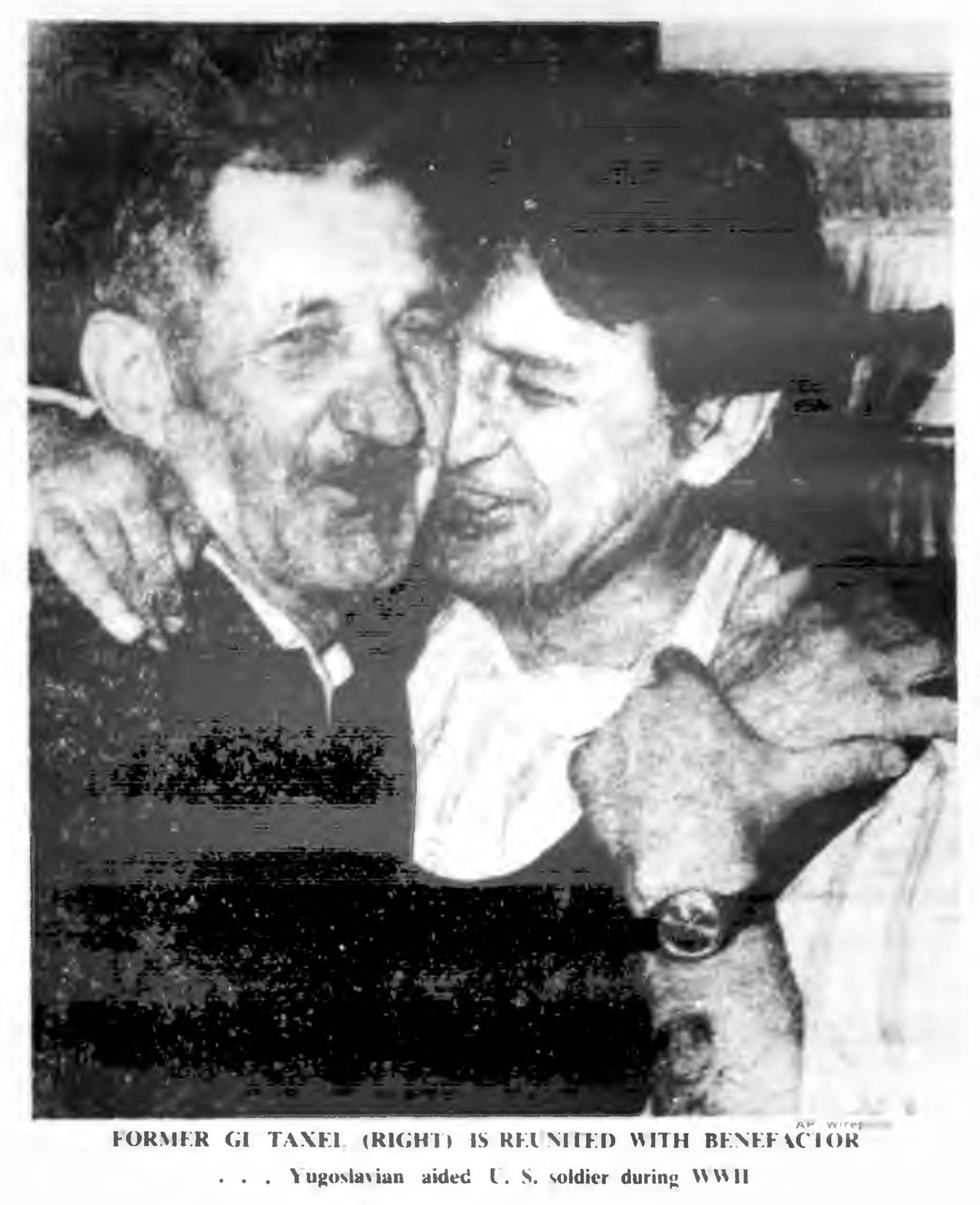 Biographical information about Stanley Taxel, whose name never appeared in American Jews in World War II, follows, along with his 1941 Erasmus Hall High School graduation portrait. (Thanks again, Ancestry.com!)
Biographical information about Stanley Taxel, whose name never appeared in American Jews in World War II, follows, along with his 1941 Erasmus Hall High School graduation portrait. (Thanks again, Ancestry.com!)
Taxel, Stanley, T/Sgt., 12156149, Radio Operator, on 48th mission
United States Army Air Force, 15th Air Force, 483rd Bomb Group, 840th Bomb Squadron
MACR 11273, Aircraft B-17G 44-6423, 10 crew – all survived; Pilot 1 Lt. Robert M.
Crash-landed near Banja-Luka, Yugoslavia; Entire crew rescued by Chetniks; Returned to base 67 days later
Born Brooklyn, N.Y., 5/5/23; Died 12/25/95
Mrs. Elaine E. Taxel (wife), 501 Avenue A, Brooklyn, N.Y.
Mr. and Mrs. Meyer [6/16/93 – 10/29/74] and Gussie (Schmidt) [1894-1960] Taxel (parents)
Harold, Irving, and Manuel (brothers), 133 Clinton St., Brooklyn, N.Y.
Cortland Standard – 6/19/74
The Batavia Daily News – 2/12/74
The Daily News (Tarrytown) – 2/11/74
The Evening News (Dutchess County) – 2/11/74
The Journal News – 6/17/74
American Jews in World War II – Not listed
Heroes of the 483rd: Crew Histories of a Much-Decorated B-17 Bomber Group During World War II – 100
Rescued After Ditching in the Philippines
Horwitz, Irving, F/O (Lt.?), Navigator
United States Army Air Force, 5th Air Force, 345th Bomb Group, 500th Bomb Squadron
No MACR, Aircraft B-25J 44-29586, Pilot 1 Lt. Lynn W. Daker, 6 crew – 5 survivors
From Lawrence Hickey’s Warpath Across the Pacific: “The poor single engine performance of the new B-25J-22s was emphasized on the 21st when the 500th’s 1st Lt. Lynn W. Daker lost an engine while skirting around a weather front which had forced cancellation of the day’s mission. Despite all efforts to lighten the ship, Daker found himself trapped down on the deck, unable to gain enough altitude for the run home. The resultant landing in the Pacific [off Negros Island, Philippines] cost the life of the engineer, S/Sgt. Desire W. Chatigny, Jr., who went to the bottom with the plane. Other planes from the flight circled overhead while a Catalina flew in to puck the five survivors from the sea.” The image below, in Warpath (from the collection of Maurice J. Eppstein), shows the rescue of the five survivors by a PBY Catalina.
 ______________________________
______________________________
Maps of the location of the plane’s ditching are shown below.
The Philippine Islands.
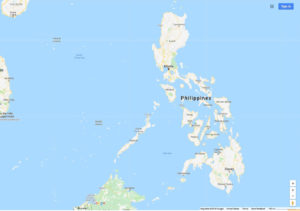 ______________________________
______________________________
A closer view. Moving from northwest to southeast, the islands are Panay, Negros, Mactan, and Panglao Island. Lt. Daker ditched his B-25 in the waters north of Cadiz City, off the coast of Negros Island.
 ______________________________
______________________________
An even closer view, showing the eastern coast of Panay and northern end of Negros Island. Google’s red location designator shows the approximate location where B-25J 44-29586 was ditched.
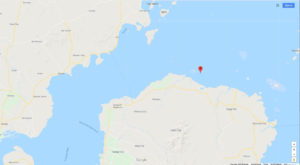 In mid-February of 2009, Lynn Daker visited the location of his aircraft’s ditching in an attempt to recover and return the remains of S/Sgt. Chatigny to his family for burial. Though the plane’s wreckage was located, little remained except for the aircraft’s two engines, the remainder of the plane probably having been removed in the intervening decades as a danger to local fishing vessels.
In mid-February of 2009, Lynn Daker visited the location of his aircraft’s ditching in an attempt to recover and return the remains of S/Sgt. Chatigny to his family for burial. Though the plane’s wreckage was located, little remained except for the aircraft’s two engines, the remainder of the plane probably having been removed in the intervening decades as a danger to local fishing vessels.
As a symbolic gesture, a bottle was filled with sand was retrieved from the ocean bottom near the plane’s engines, and, a plaque commemorating Sergeant Chatigny and identifying the plane was left on the sea floor.
Mr. Daker, head of the 345th Bomb Group Association, passed away one month later.
The plane’s crew:
Pilot – 1 Lt. Lynn W. Daker
Co-Pilot – Lt. Jensen (2 Lt. Robert W. Jensen?)
Bombardier or Navigator (both?) – F/O (Lt.?) Horwitz
Flight Engineer – S/Sgt. Desire W. Chatigny, Jr. (Newburyport, Ma.; Died in ditching)
Radio Operator or Gunner – T/Sgt. Dunn
Radio Operator or Gunner – S/Sgt. Wachtel
From Burlington, N.J. – possibly 463 High Street
American Jews in World War II – Not listed
The Strafer (345th Bomb Group Newsletter): March, 2009, V 27, N 1
Warpath: The Story of the 345th Bombardment Group In World War II – 47
Warpath Across the Pacific – The Illustrated History of the 345th Bombardment Group During World War II – 258, 395
References
Books and Periodicals
Burrows, Robert H., “Grabbing An Opportunity”, The Bulge Bugle, V 32, N 3, August 2013, pp 9-11
Chiche, F., Livre d’Or et de Sang – Les Juifs au Combat: Citations 1939-1945 de Bir-Hakeim au Rhin et Danube, Edition Brith Israel, Tunis, Tunisie, 1946
Dublin, Louis I., and Kohs, Samuel C., American Jews in World War II – The Story of 550,000 Fighters for Freedom, The Dial Press, New York, N.Y., 1947
Grimm, Jacob L., and Cole, Vernon H., Heroes of the 483rd: Crew Histories of a Much-Decorated B-17 Bomber Group During World War II, 483rd Bombardment Group (H) Association, (Georgia?), 1997
Hickey, Lawrence J., Warpath Across the Pacific – The Illustrated History of the 345th Bombardment Group During World War II, International Research and Publishing Corporation, Boulder, Co., 1984
Morris, Henry, Edited by Gerald Smith, We Will Remember Them – A Record of the Jews Who Died in the Armed Forces of the Crown 1939 – 1945, Brassey’s, United Kingdom, London, 1989
Mortensen, Max H., Warpath: The Story of the 345th Bombardment Group In World War II, (1945?)
Memorial Book of Jewish Soldiers Who Died in Battles Against Nazism – 1941-1945, Maryanovskiy, M.F., Pivovarova, N.A., Sobol, I.S. (editors), Union of Jewish War Invalids and Veterans, Moscow, Russia, 1999
Other Documents
Prisoner of War Personalkarte (Personal Card) for Pvt. Seymour Shapiro, at United States National Archives: In Records Group 242, Entry 279, Stack Area 190, Row 16, Compartment 1, Shelf 1, Box 62

